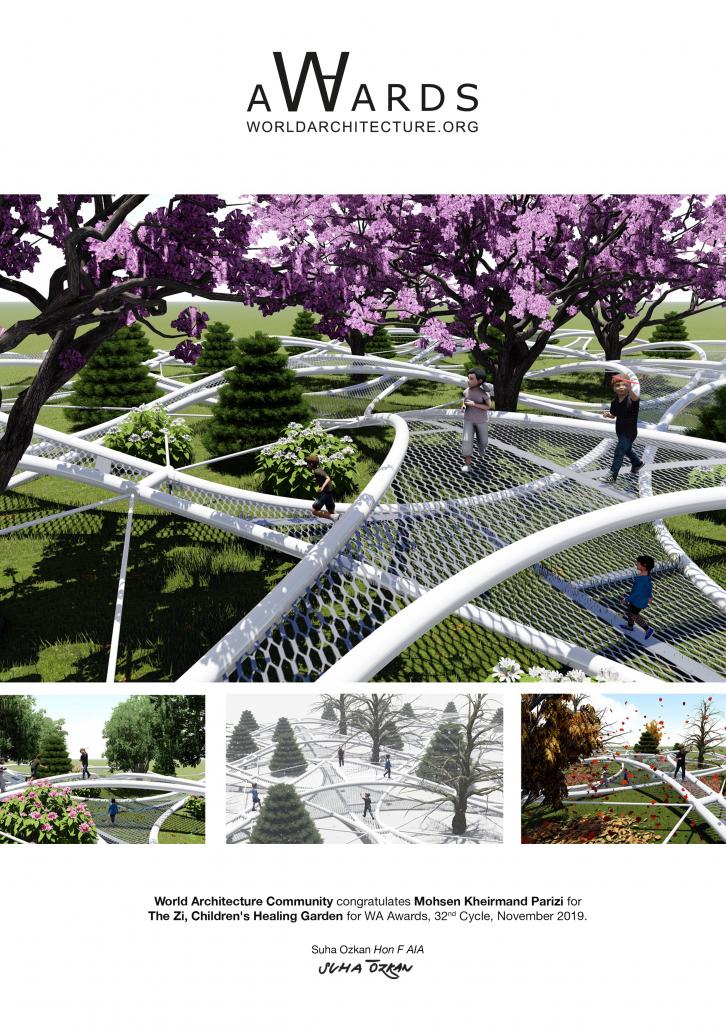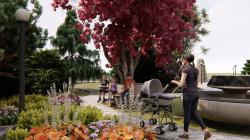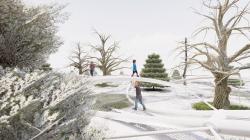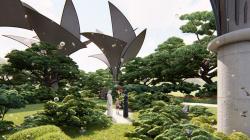a plan to lead a better and healthier life in modern cities using the principles of healing gardens and aromatherapy
Use of Aromatic Plants with Medicinal Properties and Their Fragrance Spreading due to Child Activity in Zone and Wind Transfer Aroma in Other Park Areas
Enhancing health, encouraging children to engage in activities, psychologically relevant activities for observing children's outcomes, providing opportunities for interaction, cooperation, friendships and greater familiarity with social life.
Engage users' five senses to increasecommunication along with a better understanding of the park space
...
Zi means life, and one of the goals of our group to live well is to raise the level of community health, especially for children.
Children and a better future
Children learn by playing and getting ready for life through experience. Responsive environment and activity driven Showing Activity Results A way to increase child activity in the future, when a child starts acting up and playing, he or she realizes that the activity affects the environment and learns that doing any activity will have an effect that will help him in the future.
The project addresses a research gap dealing with landscape and health. Stress is always a burden on our shoulders whether at work, on the street, or even at the house. In a search to find a deep form of sustainable landscape that would act as a stress reliever, the notion of healing gardens came into light. The project offers a practical case study for designing and formulating Healing Gardens (HG). It utilises the notion of design patterns in composing a framework that would empower the achievement of the therapeutic goals of the garden, thus providing the ability to label the garden as a healing garden. The framework is to be presented, applied, tested and reported upon by the author, who has experienced the challenge of creating Healing Gardens.
‘Health’ and ‘well being’ have always been indicators for the ‘quality of life’, while ‘quality of life’ could be perceived as a method of measuring the degree of ‘community sustainability’ (Johnson, 1995; and Dave, 2011). World Health Organisation defines health as “a state of complete physical, mental and social wellbeing and not merely the absence of disease or infirmity” (Vapaa, 2002:4). Vapaa
(2002) added that “it [health] is this basic need for a connection with nature that keeps us going” (Vapaa, 2002:18). Investigating and proving the connection between nature, healing and health a number of studies have been conducted (Kellert et al., 2008).
Health studies and horticultural therapeutic programs prove that there is a relationship
between health and gardens (Wells, 1996; Kellert et al., 2008; and Haller et al., 2006).
Gardens are not only looked at as sources of physical healing but, as mental and emotional healing sources as well (Wells, 1996). The subject of health is always important as health is something we all strive for and hope to achieve (Kellert et al.,2008). It is a positive state of life encompassing the entire life situation, and environment (Morse et al., 2011). The notion of Healing gardens should not just be restricted as a requirement for sick people, it is important for the healthy people as much as it is important for those who are sick. The paper aims to study the various types of healing gardens, targeting the most efficient form of healing gardens identified by researchers as Private Homes Healing Gardens. Moreover, the paper also presents a practical framework for the design and implementation of healing gardens through a case study. The framework was adopted and implemented by a Healing Garden Design Project Team which reports, through this project , on the practical experience in the field of designing, planning and creating private healing gardens.
Aromatherapy
Aromatherapy is the use of essential oils from the flowers, roots, leaves, seeds, bark or peel of certain plants to help boost your mood or make you feel better. Used thoughtfully and carefully, aromatherapy can help children, as well as adults, feel calmer and sleep better. It is also shown to reduce nausea, discomfort and pain.
Aromatherapy can have real benefits to children.
We’re all familiar with the pleasure that comes from an enjoyable smell, whether it’s the fragrance of a flower or a food, or a scent we associate with good memories. There are various theories as to how exactly aromatherapy works, but some believe that We’re all familiar with the pleasure that comes from an enjoyable smell, whether it’s the fragrance of a flower or a food, or a scent we associate with good memories. There are various theories as to how exactly aromatherapy works, but some believe that by activating specific smell receptors in the nose, aromatherapy causes the brain to send messages to areas of the nervous system that affect mood and other symptoms.
how can aromatherapy help your child? Aromatherapy can help calm a child who is anxious or under stress, reduce nausea, discomfort and pain, and promote healthy sleep.
Four aromatherapy oils have been determined to be both safe and effective for use with children over age 5: lavender, peppermint, orange and ginger.
Chromotherapy, Colorology & Color theory in the garden
Color directly influences the soul. Color is the keyboard, the eyes are the hammers, the soul is the piano with many strings. The artist is the hand that plays, touching one key or another purposively, to cause vibrations in the soul.
Parental monitoring
Children need care and supervision This should be in a way that prevents their activity and does not limit the child's independence.
Parents enjoy watching their child play and learn. This issue has been considered in the design of this space.
Prepare for social life and create opportunities to interact with your peers
Life is a collective activity We need to interact with others and do teamwork for life. They play together they learn and they become friends.
Flexibility of the layout with respect to the possibility of combining elements
All segments of society share in urban and urban spaces; children, the elderly, people with disabilities, and everyone in the city. This issue is considered in the design of elements and details of proposed combinations.
Social interactions: Life is a social activity. We work together to work individually and collectively in our community and the task of designers is to create a place for increasing communication between the people of the community that has been considered in the design.
We, animals and birds (equal share in the city):
We have duties against the creatures of God, they need us, and we also benefit from communication. This is the win-win interface, which, given the current state of the present-day cities, has become much diminished. Designers can, along with the participation of the people, increase the presence of these beneficial and beautiful creatures in the city.
Natural Disasters: Given the current situation and the possibility of natural disasters, the design of furniture for emergency use can be of great help to the people. Designers need to think ahead of the event
Urban Furniture with Green and Sustainable Architecture Approach:
Providing part of the energy and water from the environment and the proposed use of recycled materials can be the starting point for a revolution in the design of future urban furniture.
CULTURE AND ART: The interplay of space on furniture, users and buildings in this area should be managed and designed to create conditions suitable for cultural, artistic and related activities. The introduction of several books and the call for public participation with The purpose of the book exchange, the use of audio books, music broadcasting, religious expressions, scientific advice and advice on the choice of the user, and the taste of the user of furniture, have been studied in this project.
We deserve the best. Interactive spaces, group work, urban furniture ideas are on the rise day by day. An advancement that increases human interactions, the collective mood, physical and mental health of users. Spending in these cases is a factor in preventing many future problems, and this is a high return investment.
Urban Furniture and Memories: A space to record memories with the date, time, sense of the user, and the evacuation of negative thoughts from the pressures on the user can be a factor in the constant use and return of the user to space. In addition, the psychological dimension is very influential on people.
Cultural dimension: equipping the furniture with the book and even the audio book to select the user's interest, playing music, poetry, motivational messages and advice, scientific tips and lessons can help in enhancing the cultural level of users.
Respecting the user: Designing an optical sensor and illuminating the space around the furniture when approaching the user is a way of expressing value and respecting users and attracting more to the use of furniture.
Selection of materials: the selection of suitable materials with high thermal capacity, the supply of thermal energy through solar cells, shading through the use of plants in the warm seasons, fragrant space with medicinal properties, make the conditions possible for the use of urban furniture, at all times and all seasons .
References
Johnson, C. W., 1995. Planning and designing for the multiple use role of habitats in urban/suburban
landscapes in the Great Basin. Landurbplan 32, 219-225.
Kellert, S. R., Heerwagen, J. H., Mador, M. L., 2008. Biophilic Design: The Theory, Science and
Practice of Bringing Buildings to Life. John Wiley & Sons, Inc., Hoboken, New Jersey.
Morse, S., Vogiatzakis, I., Griffiths, G., 2011. Space and Sustainability. Poltential for landscape a
Spatial Unit for Assessing Sustainability. Sust. Dev. 19, 30-48.
Shahcheraghi, A., Bandarabad, AR., 2016. Environed in Environment: Application of Environmental Psychology in Architecture and Urban Design. Tehran. iranian student book agency (ISBA).
Zojaji,N., Nikbakht,A. , Kafi,M. ,Design Principles of Clinical Sites with Emphasis on Components
of Healing gardens, Horticultural Therapy Spaces and
The Persian Garden. J.Env. Sci. Tech., Vol 18, Special No.2, Winter 2016
Vapaa, A. G., 2002. Healing Gardens: Creating Places for Restoration, Meditation and Sanctuary:
What are defining characteristics that make a healing garden? A thesis for Master’s of Landscape
Architecture. College of Architecture and Urban Studies. Virginia Polytechnic Institute and State
University.
Wells, S. E., 1996. Horticultural Therapy and the Older Adult Population. The Haworth Press, Inc.,
Binghamton, NY
2019
2019
Other design principles used in the project:
Design according to the principles
Territory, personal space, privacy & social connections
The balance between sociability and individual privacy in park spaces, Anyone considering the personal and mental characteristics he or she decides to place in sociable or secluded spaces should be aware that users have a choice and our design should not limit them, this is used in the design of our group.
Flexible design according to the taste and circumstances of each individual is a subject that should be used in the design of the play space.
Given the need for children to be safe in space, one of the key principles in the design of the CPTED (Crime prevention through environmental design) attention set has been.
In feature-centric design, the form capability for activities is examined.
Behavioral design in designing access routes
In the design of the neighborhood park, observation of local people is a priority given to the passage of time and personal experience created by the observer prior to entering this design and used in the design.
24-hour use
Use Public Participation Opportunity
Healing plants
Solar Energy
Charging electrical appliances
Plot games
Collect and store water
Supplying oxygen
Usability of users with movement restrictions
Opportunity to create communication and social interactions
Use in all seasons of the year
Opportunity to register the artwork and culture of users
Mohsen Kheirmand Parizi
Seyed Mohammadhossein Rahmati
Alireza Salmani
Niosha Nazemzomorodi
Marjan Mirsharifi
Mahdieh Vamegh
Mohammadreza Moghadasi
Special thanks for advice from:
DR. Azadeh Shahcheraghi
DR. Mohsen Kafi
The Zi, Children's Healing Garden by Mohsen Kheirmand Parizi in Iran won the WA Award Cycle 32. Please find below the WA Award poster for this project.

Downloaded 142 times.
Favorited 12 times








